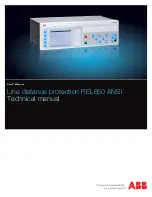
GCHK-100 Instruction Manual I-GARD
3
2
catalog numBerS
Table 2.1 indicates the product group for the GCHK-100 family from I-Gard
Table 2.1 CaTalOG NUMbeRS
Catalog Number
Description
No Required/System
GCHK-100
Mining Relay
1
GCHK-DRI
LED Based remote indicator
1*
GCHK-ZT
Ground Check zener terminator
1
mGARD-SYM
Remote Indicator
1*
T series
ZSCS current sensors
1
*Either GCHK-DRI or mGARD-SYM can be used (or both if desired), however it is not necessary; in fact, the
GCHK-100 can be used without either of them.
3
current SenSorS
Ground fault detection is achieved by the use of an external Zero Sequence Current Sensor (ZSCS). The relay
supports the following zero sequence current sensors or current transformers:
Any I-Gard T type sensors (e.g. T2A, T3A, T6A and T9A)
1000:1
10:0.0167
(600:1) Bender
200:5
(40:1) Startco
Surge protection is built into the relay; please refer to the electrical specifications data for withstand ratings.
ZSCS with, or without, built-in protection can be used with the GCHK-100 relay. The terminal block provides a
common ground and a terminal location for each of the three sensor types.
*
Note:
Only one type of ZSCS can be used at a time.
4
pilot Wire terminator
This terminating diode is standard throughout the industry. It has two terminals marked GC and G. The GC
terminal is connected to the pilot wire inside the mobile equipment enclosure. The G terminal of the GCHK-ZT
is connected to the frame ground of the mobile equipment. The purpose of the diode is to allow the ground fault
relay to determine if the ground loop has been shorted. A shorted ground loop would appear as normal loop
impedance if this were allowed to happen, while in fact, the mobile equipment may be completely ungrounded.
Loss of zener voltage therefore causes the TRIP relay to operate and disconnect the power.
Summary of Contents for GCHK-100
Page 20: ...the power to protect...





































